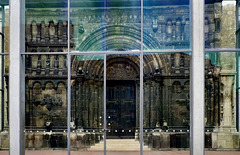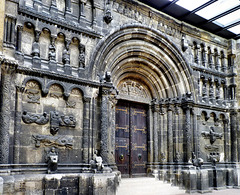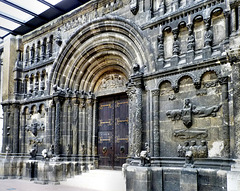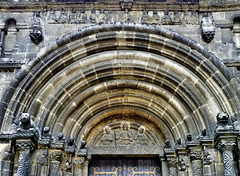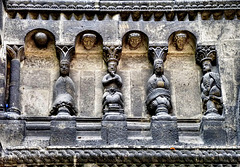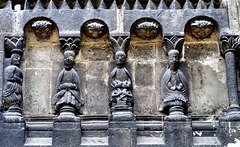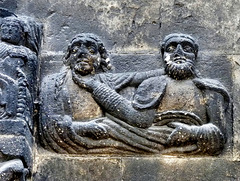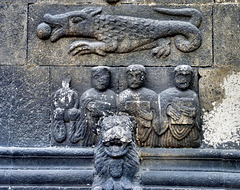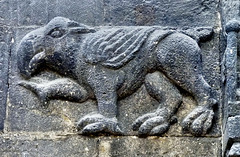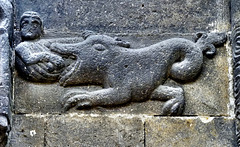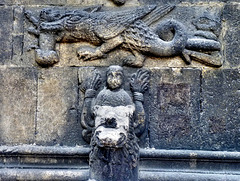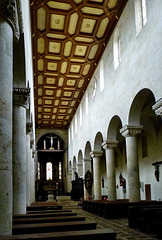
Bavaria / Bayern
All these photos just have in common, that they were taken in Bavaria
Regensburg - Schottenkloster St. Jakob
| |
|
A Benedictian monastery was founded by Hiberno-Scottish monks in Regensburg already around 1070. Soon after, the convent moved to a place just outside the city walls and in started to erect first buildings.
The first church, consecrated in 1120, was of such a poor workmanship, that the convent decided to tear it down (except one apse and the flanking towers) and restart the process. The church of today was completed before 1200. It is one of the most important Romanesque structures in Bavaria.
The abbey was a hub for the Irish/Scottish mission to central Europe. Daughter establishments of St. Jakob were founded in Vienna (1155), Erfurt (1136), Wuerzburg (1138), Nuremberg (1140), Constance (1142), Eichstaett (1148), Memmingen (1178), Kiev (!) (late 12th century) and Kelheim (13th century).
WHile the first monks and abbots were Irish, the Scottish period started after the Reformation with Scottish abbot Ninian Vincet (1577-1592). A century later Scottish priests were educated here to do missionary work back in Scotland.
Abbot Benedikt Aburthnot (1737-1820) could avoid the secularisation in 1802 by making clear, that the monastery was a Scottish (not at all Bavarian!) national treasure. It took upto 1814 to incorporate the Scottish monastery into the Bavarian sovereignty. Monastic life finally ended here in 1862, when the buildings were taken over by the bishop, who 10 years later founded a still existing seminary here.
The northern portal ("Schottenportal") is one of the most important (and largest) Romanesque works of art in Germany. It occupies a third of the church´s northern wall. As the (meanwhile blackened) carvings suffered severely from pollution, a glass-pavillion is erected to protect the "Schottenportal". To get the whole portal on one shot - I had to take that from outside the pavillion.
Regensburg - Schottenkloster St. Jakob
| |
|
A Benedictian monastery was founded by Hiberno-Scottish monks in Regensburg already around 1070. Soon after, the convent moved to a place just outside the city walls and in started to erect first buildings.
The first church, consecrated in 1120, was of such a poor workmanship, that the convent decided to tear it down (except one apse and the flanking towers) and restart the process. The church of today was completed before 1200. It is one of the most important Romanesque structures in Bavaria.
The abbey was a hub for the Irish/Scottish mission to central Europe. Daughter establishments of St. Jakob were founded in Vienna (1155), Erfurt (1136), Wuerzburg (1138), Nuremberg (1140), Constance (1142), Eichstaett (1148), Memmingen (1178), Kiev (!) (late 12th century) and Kelheim (13th century).
WHile the first monks and abbots were Irish, the Scottish period started after the Reformation with Scottish abbot Ninian Vincet (1577-1592). A century later Scottish priests were educated here to do missionary work back in Scotland.
Abbot Benedikt Aburthnot (1737-1820) could avoid the secularisation in 1802 by making clear, that the monastery was a Scottish (not at all Bavarian!) national treasure. It took upto 1814 to incorporate the Scottish monastery into the Bavarian sovereignty. Monastic life finally ended here in 1862, when the buildings were taken over by the bishop, who 10 years later founded a still existing seminary here.
The northern portal ("Schottenportal") is one of the most important (and largest) Romanesque works of art in Germany. It occupies about a third of the church´s northern wall and is divided into thirds both horizontally and vertically, plus a small frieze that tops the central arch (the vertical center).
While most authors reckon, that Irish masters created this portal, Marcel Durliat sees parallels to works in Northern Italy, created by the Comacine masters ("Magistri Comacini"). He even connects this portal to the carvings in Linden and Remagen. I doubt that..
The dimensions of the protective glass pavillion (and the limited features if my camera) made it impossible to get the portal "in toto" on one picture. The previous shot was done from the right, this one was done frm the left side of the portal.
Regensburg - Schottenkloster St. Jakob
| |
|
A Benedictian monastery was founded by Hiberno-Scottish monks in Regensburg already around 1070. Soon after, the convent moved to a place just outside the city walls and in started to erect first buildings.
The first church, consecrated in 1120, was of such a poor workmanship, that the convent decided to tear it down (except one apse and the flanking towers) and restart the process. The church of today was completed before 1200. It is one of the most important Romanesque structures in Bavaria.
The abbey was a hub for the Irish/Scottish mission to central Europe. Daughter establishments of St. Jakob were founded in Vienna (1155), Erfurt (1136), Wuerzburg (1138), Nuremberg (1140), Constance (1142), Eichstaett (1148), Memmingen (1178), Kiev (!) (late 12th century) and Kelheim (13th century).
WHile the first monks and abbots were Irish, the Scottish period started after the Reformation with Scottish abbot Ninian Vincet (1577-1592). A century later Scottish priests were educated here to do missionary work back in Scotland.
Abbot Benedikt Aburthnot (1737-1820) could avoid the secularisation in 1802 by making clear, that the monastery was a Scottish (not at all Bavarian!) national treasure. It took upto 1814 to incorporate the Scottish monastery into the Bavarian sovereignty. Monastic life finally ended here in 1862, when the buildings were taken over by the bishop, who 10 years later founded a still existing seminary here.
The northern portal ("Schottenportal") is one of the most important (and largest) Romanesque works of art in Germany. It occupies about a third of the church´s northern wall and is divided into thirds both horizontally and vertically, plus a small frieze that tops the central arch (the vertical center).
While most authors reckon, that Irish masters created this portal, Marcel Durliat sees parallels to works in Northern Italy, created by the Comacine masters ("Magistri Comacini"). He even connects this portal to the carvings in Linden and Remagen. I doubt that..
The dimensions of the protective glass pavillion (and the limited features if my camera) made it impossible to get the portal "in toto" on one picture. For the previous shot I had left the pavillion.
This now is the portal seen from right. The next upload will be - the portal seen from the left.
Regensburg - Schottenkloster St. Jakob
| |
|
A Benedictian monastery was founded by Hiberno-Scottish monks in Regensburg already around 1070. Soon after, the convent moved to a place just outside the city walls and in started to erect first buildings.
The first church, consecrated in 1120, was of such a poor workmanship, that the convent decided to tear it down (except one apse and the flanking towers) and restart the process. The church of today was completed before 1200. It is one of the most important Romanesque structures in Bavaria.
The abbey was a hub for the Irish/Scottish mission to central Europe. Daughter establishments of St. Jakob were founded in Vienna (1155), Erfurt (1136), Wuerzburg (1138), Nuremberg (1140), Constance (1142), Eichstaett (1148), Memmingen (1178), Kiev (!) (late 12th century) and Kelheim (13th century).
WHile the first monks and abbots were Irish, the Scottish period started after the Reformation with Scottish abbot Ninian Vincet (1577-1592). A century later Scottish priests were educated here to do missionary work back in Scotland.
Abbot Benedikt Aburthnot (1737-1820) could avoid the secularisation in 1802 by making clear, that the monastery was a Scottish (not at all Bavarian!) national treasure. It took upto 1814 to incorporate the Scottish monastery into the Bavarian sovereignty. Monastic life finally ended here in 1862, when the buildings were taken over by the bishop, who 10 years later founded a still existing seminary here.
The northern portal ("Schottenportal") is one of the most important (and largest) Romanesque works of art in Germany. It occupies a third of the church´s northern wall and is divided into thirds both horizontally and vertically, plus a small frieze that tops the central arch (the vertical center).
While most authors reckon, that Irish masters created this portal, Marcel Durliat sees parallels to works in Northern Italy, created by the Comacine masters ("Magistri Comacini"). He even connects this portal to the carvings in Linden and Remagen. I doubt that..
Multiple semicircular archivolts form the arch, below the frieze, just seen. The tympanum depicts Christ in a blessing gesture flanked by Saint James and Saint John, who holds up an open bible.
The entrance is guarded by a pride of lions. Five male lions are on the pillars to the right, five female lions are on the pillars to the left.
Regensburg - Schottenkloster St. Jakob
| |
|
A Benedictian monastery was founded by Hiberno-Scottish monks in Regensburg already around 1070. Soon after, the convent moved to a place just outside the city walls and in started to erect first buildings.
The first church, consecrated in 1120, was of such a poor workmanship, that the convent decided to tear it down (except one apse and the flanking towers) and restart the process. The church of today was completed before 1200. It is one of the most important Romanesque structures in Bavaria.
The abbey was a hub for the Irish/Scottish mission to central Europe. Daughter establishments of St. Jakob were founded in Vienna (1155), Erfurt (1136), Wuerzburg (1138), Nuremberg (1140), Constance (1142), Eichstaett (1148), Memmingen (1178), Kiev (!) (late 12th century) and Kelheim (13th century).
WHile the first monks and abbots were Irish, the Scottish period started after the Reformation with Scottish abbot Ninian Vincet (1577-1592). A century later Scottish priests were educated here to do missionary work back in Scotland.
Abbot Benedikt Aburthnot (1737-1820) could avoid the secularisation in 1802 by making clear, that the monastery was a Scottish (not at all Bavarian!) national treasure. It took upto 1814 to incorporate the Scottish monastery into the Bavarian sovereignty. Monastic life finally ended here in 1862, when the buildings were taken over by the bishop, who 10 years later founded a still existing seminary here.
The northern portal ("Schottenportal") is one of the most important (and largest) Romanesque works of art in Germany. It occupies a third of the church´s northern wall and is divided into thirds both horizontally and vertically, plus a small frieze that tops the central arch (the vertical center).
While most authors reckon, that Irish masters created this portal, Marcel Durliat sees parallels to works in Northern Italy, created by the Comacine masters ("Magistri Comacini"). He even connects this portal to the carvings in Linden and Remagen. I doubt that..
The interpretation of such a large and cryptic portal has been controversial since the beginning, what means the 19th century, as only since then Romanesque carvings were seen as works of art (mostly). There was even a theory claiming that such a carving could not have been done during the 12th/13th century, and that it probably was added to the church later. The time of origin is not disputed any longer, but the meaning of figures and symbols. Richard Strobel ("Romanik in Altbayern") has no hard facts, but found out, that left (eastern) side stands for the "Good", while the right side stands for the "Evil". This meanwhile is undisputed.
This is from the left side - and the figures may stand for virtues. The remind me on early drawings of native Americans, but that can´t be. Note the three human heads under the arches. They all have very curly hair and seem to be more "vivid", than the stoic looking caryatids below them.
Next upload will have the same position of the right side.
Regensburg - Schottenkloster St. Jakob
| |
|
|
|
A Benedictian monastery was founded by Hiberno-Scottish monks in Regensburg already around 1070. Soon after, the convent moved to a place just outside the city walls and in started to erect first buildings.
The first church, consecrated in 1120, was of such a poor workmanship, that the convent decided to tear it down (except one apse and the flanking towers) and restart the process. The church of today was completed before 1200. It is one of the most important Romanesque structures in Bavaria.
The abbey was a hub for the Irish/Scottish mission to central Europe. Daughter establishments of St. Jakob were founded in Vienna (1155), Erfurt (1136), Wuerzburg (1138), Nuremberg (1140), Constance (1142), Eichstaett (1148), Memmingen (1178), Kiev (!) (late 12th century) and Kelheim (13th century).
WHile the first monks and abbots were Irish, the Scottish period started after the Reformation with Scottish abbot Ninian Vincet (1577-1592). A century later Scottish priests were educated here to do missionary work back in Scotland.
Abbot Benedikt Aburthnot (1737-1820) could avoid the secularisation in 1802 by making clear, that the monastery was a Scottish (not at all Bavarian!) national treasure. It took upto 1814 to incorporate the Scottish monastery into the Bavarian sovereignty. Monastic life finally ended here in 1862, when the buildings were taken over by the bishop, who 10 years later founded a still existing seminary here.
The northern portal ("Schottenportal") is one of the most important (and largest) Romanesque works of art in Germany. It occupies a third of the church´s northern wall and is divided into thirds both horizontally and vertically, plus a small frieze that tops the central arch (the vertical center).
While most authors reckon, that Irish masters created this portal, Marcel Durliat sees parallels to works in Northern Italy, created by the Comacine masters ("Magistri Comacini"). He even connects this portal to the carvings in Linden and Remagen.
The interpretation of such a large and cryptic portal has been controversial since the beginning, what means the 19th century, as only since then Romanesque carvings were seen as works of art (mostly). There was even a theory claiming that such a carving could not have been done during the 12th/13th century, and that it probably was added to the church later. The time of origin is not disputed any longer, but the meaning of figures and symbols. Richard Strobel ("Romanik in Altbayern") has no hard facts, but found out, that left (eastern) side stands for the "Good", while the right side stands for the "Evil". This meanwhile is undisputed.
Seen on the previous upload was the left side, here is the rightside.
Where three human heads (and a ball) under the arches were left, here are four animal heads (probably lions). If the figures on the left stand for virtues, these figures may stand for vices. Three of these caryatids are men (have beards), one is a woman. The lady holds two snakes - and is widely interpreted as a Luxuria, a symbol of evil lust. I have seen many Luxurias, all of them were nude, breastfeeding snakes or toads, so I doubt that interpretation, but cannot offer any other..
I will upload a close up of the "Luxuria" next.
Regensburg - Schottenkloster St. Jakob
| |
|
A Benedictian monastery was founded by Hiberno-Scottish monks in Regensburg already around 1070. Soon after, the convent moved to a place just outside the city walls and in started to erect first buildings.
The first church, consecrated in 1120, was of such a poor workmanship, that the convent decided to tear it down (except one apse and the flanking towers) and restart the process. The church of today was completed before 1200. It is one of the most important Romanesque structures in Bavaria.
The abbey was a hub for the Irish/Scottish mission to central Europe. Daughter establishments of St. Jakob were founded in Vienna (1155), Erfurt (1136), Wuerzburg (1138), Nuremberg (1140), Constance (1142), Eichstaett (1148), Memmingen (1178), Kiev (!) (late 12th century) and Kelheim (13th century).
WHile the first monks and abbots were Irish, the Scottish period started after the Reformation with Scottish abbot Ninian Vincet (1577-1592). A century later Scottish priests were educated here to do missionary work back in Scotland.
Abbot Benedikt Aburthnot (1737-1820) could avoid the secularisation in 1802 by making clear, that the monastery was a Scottish (not at all Bavarian!) national treasure. It took upto 1814 to incorporate the Scottish monastery into the Bavarian sovereignty. Monastic life finally ended here in 1862, when the buildings were taken over by the bishop, who 10 years later founded a still existing seminary here.
The northern portal ("Schottenportal") is one of the most important (and largest) Romanesque works of art in Germany. It occupies a third of the church´s northern wall and is divided into thirds both horizontally and vertically, plus a small frieze that tops the central arch (the vertical center).
While most authors reckon, that Irish masters created this portal, Marcel Durliat sees parallels to works in Northern Italy, created by the Comacine masters ("Magistri Comacini"). He even connects this portal to the carvings in Linden and Remagen.
The interpretation of such a large and cryptic portal has been controversial since the beginning, what means the 19th century, as only since then Romanesque carvings were seen as works of art (mostly). There was even a theory claiming that such a carving could not have been done during the 12th/13th century, and that it probably was added to the church later. The time of origin is not disputed any longer, but the meaning of figures and symbols. Richard Strobel ("Romanik in Altbayern") has no hard facts, but found out, that left (eastern) side stands for the "Good", while the right side stands for the "Evil". This meanwhile is undisputed.
This is the largest "third" of the left side.
In the center a (headless) Virgin, having Christ on her lap. She holds an apple in her hand, a symbol of the "New Eve". The Virgin flanked by two mythical pairs. The left couple seems to be floating. The right person is bearded and wears two braids.The couple to the right seems to be in a beardpulling gesture, but is not. The left person is female (long braids) - and her husband (beard) obviously strokes her under the chin. Above them are (under the arches) two dogs - not three. Below them a large winged dragon, devouring a lion. In the center, below the dragon is a mermaids (note the tails), placed on a very weathered lion - and to the right another person riding a weathered lion.
Regensburg - Schottenkloster St. Jakob
| |
|
A Benedictian monastery was founded by Hiberno-Scottish monks in Regensburg already around 1070. Soon after, the convent moved to a place just outside the city walls and in started to erect first buildings.
The first church, consecrated in 1120, was of such a poor workmanship, that the convent decided to tear it down (except one apse and the flanking towers) and restart the process. The church of today was completed before 1200. It is one of the most important Romanesque structures in Bavaria.
The abbey was a hub for the Irish/Scottish mission to central Europe. Daughter establishments of St. Jakob were founded in Vienna (1155), Erfurt (1136), Wuerzburg (1138), Nuremberg (1140), Constance (1142), Eichstaett (1148), Memmingen (1178), Kiev (!) (late 12th century) and Kelheim (13th century).
WHile the first monks and abbots were Irish, the Scottish period started after the Reformation with Scottish abbot Ninian Vincet (1577-1592). A century later Scottish priests were educated here to do missionary work back in Scotland.
Abbot Benedikt Aburthnot (1737-1820) could avoid the secularisation in 1802 by making clear, that the monastery was a Scottish (not at all Bavarian!) national treasure. It took upto 1814 to incorporate the Scottish monastery into the Bavarian sovereignty. Monastic life finally ended here in 1862, when the buildings were taken over by the bishop, who 10 years later founded a still existing seminary here.
The northern portal ("Schottenportal") is one of the most important (and largest) Romanesque works of art in Germany. It occupies a third of the church´s northern wall and is divided into thirds both horizontally and vertically, plus a small frieze that tops the central arch (the vertical center).
While most authors reckon, that Irish masters created this portal, Marcel Durliat sees parallels to works in Northern Italy, created by the Comacine masters ("Magistri Comacini"). He even connects this portal to the carvings in Linden and Remagen.
The interpretation of such a large and cryptic portal has been controversial since the beginning, what means the 19th century, as only since then Romanesque carvings were seen as works of art (mostly). There was even a theory claiming that such a carving could not have been done during the 12th/13th century, and that it probably was added to the church later. The time of origin is not disputed any longer, but the meaning of figures and symbols. Richard Strobel ("Romanik in Altbayern") has no hard facts, but found out, that left (eastern) side stands for the "Good", while the right side stands for the "Evil". This meanwhile is undisputed.
This is another detail the from the left side.
This is the couple right of the Virgin (see Jesus´ head and hand). At first I saw a beard-puller, but that is totally wrong. The close-up shows a loving couple in a very intimate gesture (for that time!). While she fingers the back of his neck, he strokes her under the chin.
Regensburg - Schottenkloster St. Jakob
| |
|
A Benedictian monastery was founded by Hiberno-Scottish monks in Regensburg already around 1070. Soon after, the convent moved to a place just outside the city walls and in started to erect first buildings.
The first church, consecrated in 1120, was of such a poor workmanship, that the convent decided to tear it down (except one apse and the flanking towers) and restart the process. The church of today was completed before 1200. It is one of the most important Romanesque structures in Bavaria.
The abbey was a hub for the Irish/Scottish mission to central Europe. Daughter establishments of St. Jakob were founded in Vienna (1155), Erfurt (1136), Wuerzburg (1138), Nuremberg (1140), Constance (1142), Eichstaett (1148), Memmingen (1178), Kiev (!) (late 12th century) and Kelheim (13th century).
WHile the first monks and abbots were Irish, the Scottish period started after the Reformation with Scottish abbot Ninian Vincet (1577-1592). A century later Scottish priests were educated here to do missionary work back in Scotland.
Abbot Benedikt Aburthnot (1737-1820) could avoid the secularisation in 1802 by making clear, that the monastery was a Scottish (not at all Bavarian!) national treasure. It took upto 1814 to incorporate the Scottish monastery into the Bavarian sovereignty. Monastic life finally ended here in 1862, when the buildings were taken over by the bishop, who 10 years later founded a still existing seminary here.
The northern portal ("Schottenportal") is one of the most important (and largest) Romanesque works of art in Germany. It occupies a third of the church´s northern wall and is divided into thirds both horizontally and vertically, plus a small frieze that tops the central arch (the vertical center).
While most authors reckon, that Irish masters created this portal, Marcel Durliat sees parallels to works in Northern Italy, created by the Comacine masters ("Magistri Comacini"). He even connects this portal to the carvings in Linden and Remagen. I doubt that..
The right side of the center has five snarling, fierce looking male lions, all having manes. The pillars are elaborately decorated with foliage. The middle-pillar has a bird, pecking grapes, just under the capital, from where a person looks down. There are three persons seen between the pillars (on their knees). The left one may be an acrobat, the middle, bearded one is a musician, playing a small string instrument. The right one, dressed in a kind of cape, holds his hands on his stomach.
Regensburg - Schottenkloster St. Jakob
| |
|
A Benedictian monastery was founded by Hiberno-Scottish monks in Regensburg already around 1070. Soon after, the convent moved to a place just outside the city walls and in started to erect first buildings.
The first church, consecrated in 1120, was of such a poor workmanship, that the convent decided to tear it down (except one apse and the flanking towers) and restart the process. The church of today was completed before 1200. It is one of the most important Romanesque structures in Bavaria.
The abbey was a hub for the Irish/Scottish mission to central Europe. Daughter establishments of St. Jakob were founded in Vienna (1155), Erfurt (1136), Wuerzburg (1138), Nuremberg (1140), Constance (1142), Eichstaett (1148), Memmingen (1178), Kiev (!) (late 12th century) and Kelheim (13th century).
WHile the first monks and abbots were Irish, the Scottish period started after the Reformation with Scottish abbot Ninian Vincet (1577-1592). A century later Scottish priests were educated here to do missionary work back in Scotland.
Abbot Benedikt Aburthnot (1737-1820) could avoid the secularisation in 1802 by making clear, that the monastery was a Scottish (not at all Bavarian!) national treasure. It took upto 1814 to incorporate the Scottish monastery into the Bavarian sovereignty. Monastic life finally ended here in 1862, when the buildings were taken over by the bishop, who 10 years later founded a still existing seminary here.
The northern portal ("Schottenportal") is one of the most important (and largest) Romanesque works of art in Germany. It occupies a third of the church´s northern wall and is divided into thirds both horizontally and vertically, plus a small frieze that tops the central arch (the vertical center).
While most authors reckon, that Irish masters created this portal, Marcel Durliat sees parallels to works in Northern Italy, created by the Comacine masters ("Magistri Comacini"). He even connects this portal to the carvings in Linden and Remagen.
The interpretation of such a large and cryptic portal has been controversial since the beginning, what means the 19th century, as only since then Romanesque carvings were seen as works of art (mostly). There was even a theory claiming that such a carving could not have been done during the 12th/13th century, and that it probably was added to the church later. The time of origin is not disputed any longer, but the meaning of figures and symbols. Richard Strobel ("Romanik in Altbayern") has no hard facts, but found out, that left (eastern) side stands for the "Good", while the right side stands for the "Evil". This meanwhile is undisputed.
If the figures on the left stand for virtues, the figures on the right side stand for vices. This is a close up of the only woman on the right side, just seen. She holds two snakes - and is widely interpreted as a Luxuria, a symbol of evil lust.
I have seen quite a couple Luxurias [ www.flickr.com/photos/martin-m-miles/sets/721576304409392... ]. All of them were nude, breastfeeding snakes or toads. This figure holds snakes, but is fully dressed - and has (like all others here) a very stoic facial expression.
Regensburg - Schottenkloster St. Jakob
| |
|
A Benedictian monastery was founded by Hiberno-Scottish monks in Regensburg already around 1070. Soon after, the convent moved to a place just outside the city walls and in started to erect first buildings.
The first church, consecrated in 1120, was of such a poor workmanship, that the convent decided to tear it down (except one apse and the flanking towers) and restart the process. The church of today was completed before 1200. It is one of the most important Romanesque structures in Bavaria.
The abbey was a hub for the Irish/Scottish mission to central Europe. Daughter establishments of St. Jakob were founded in Vienna (1155), Erfurt (1136), Wuerzburg (1138), Nuremberg (1140), Constance (1142), Eichstaett (1148), Memmingen (1178), Kiev (!) (late 12th century) and Kelheim (13th century).
WHile the first monks and abbots were Irish, the Scottish period started after the Reformation with Scottish abbot Ninian Vincet (1577-1592). A century later Scottish priests were educated here to do missionary work back in Scotland.
Abbot Benedikt Aburthnot (1737-1820) could avoid the secularisation in 1802 by making clear, that the monastery was a Scottish (not at all Bavarian!) national treasure. It took upto 1814 to incorporate the Scottish monastery into the Bavarian sovereignty. Monastic life finally ended here in 1862, when the buildings were taken over by the bishop, who 10 years later founded a still existing seminary here.
The northern portal ("Schottenportal") is one of the most important (and largest) Romanesque works of art in Germany. It occupies a third of the church´s northern wall and is divided into thirds both horizontally and vertically, plus a small frieze that tops the central arch (the vertical center).
While most authors reckon, that Irish masters created this portal, Marcel Durliat sees parallels to works in Northern Italy, created by the Comacine masters ("Magistri Comacini"). He even connects this portal to the carvings in Linden and Remagen.
The interpretation of such a large and cryptic portal has been controversial since the beginning, what means the 19th century, as only since then Romanesque carvings were seen as works of art (mostly). There was even a theory claiming that such a carving could not have been done during the 12th/13th century, and that it probably was added to the church later. The time of origin is not disputed any longer, but the meaning of figures and symbols. Richard Strobel ("Romanik in Altbayern") has no hard facts, but found out, that left (eastern) side stands for the "Good", while the right side stands for the "Evil". This meanwhile is undisputed.
A detail from the rigt side.
As seen on the previous shot: the crocodile and the hydrus (snake), what may stand as a symbol of the resurrection of Christ. Following the story from the Physiologus, the crocodile rolls the hydrus in mud, before eating it. Once inside the crocodile's stomach, the hydrus would burst free - and kill the crocodile "from inside".
Below these two mythical creatures, and so probably in the hell´s lowest level are three persons/souls - and a (weathered) mermaid. The trio is well dressed, has short hair (tonsure?) and holds books. So they may be well educated monks, but obviously they followed the mermaid into a sinful life - and so their souls ended here.
In front a weathered lion. The lion´s paws rest on the shoulders of a small human. He will be devoured by the lion within short.
Regensburg - Schottenkloster St. Jakob
| |
|
A Benedictian monastery was founded by Hiberno-Scottish monks in Regensburg already around 1070. Soon after, the convent moved to a place just outside the city walls and in started to erect first buildings.
The first church, consecrated in 1120, was of such a poor workmanship, that the convent decided to tear it down (except one apse and the flanking towers) and restart the process. The church of today was completed before 1200. It is one of the most important Romanesque structures in Bavaria.
The abbey was a hub for the Irish/Scottish mission to central Europe. Daughter establishments of St. Jakob were founded in Vienna (1155), Erfurt (1136), Wuerzburg (1138), Nuremberg (1140), Constance (1142), Eichstaett (1148), Memmingen (1178), Kiev (!) (late 12th century) and Kelheim (13th century).
While the first monks and abbots were Irish, the Scottish period started after the Reformation with Scottish abbot Ninian Vincet (1577-1592). A century later Scottish priests were educated here to do missionary work back in Scotland.
Abbot Benedikt Aburthnot (1737-1820) could avoid the secularisation in 1802 by making clear, that the monastery was a Scottish (not at all Bavarian!) national treasure. It took upto 1814 to incorporate the Scottish monastery into the Bavarian sovereignty. Monastic life finally ended here in 1862, when the buildings were taken over by the bishop, who 10 years later founded a still existing seminary here.
The northern portal ("Schottenportal") is one of the most important (and largest) Romanesque works of art in Germany. It occupies a third of the churchÂŽs northern wall and is divided into thirds both horizontally and vertically, plus a small frieze that tops the central arch (the vertical center).
While most authors reckon, that Irish masters created this portal, Marcel Durliat sees parallels to works in Northern Italy, created by the Comacine masters ("Magistri Comacini"). He even connects this portal to the carvings in Linden and Remagen.
The interpretation of such a large and cryptic portal has been controversial since the beginning, what means the 19th century, as only since then Romanesque carvings were seen as works of art (mostly). There was even a theory claiming that such a carving could not have been done during the 12th/13th century, and that it probably was added to the church later. The time of origin is not disputed any longer, but the meaning of figures and symbols. Richard Strobel ("Romanik in Altbayern") has no hard facts, but found out, that left (eastern) side stands for the "Good", while the right side stands for the "Evil". This meanwhile is undisputed.
A detail from the right (evil) side.
This is a close up of the strange quadruped animal left to the Antichrist. It has a kind of mane and a beak-like mouth. I had the impression, that this may be a chimare, but I learned from Ray, that this is probably an assirian griffin. See below..
Regensburg - Schottenkloster St. Jakob
| |
|
A Benedictian monastery was founded by Hiberno-Scottish monks in Regensburg already around 1070. Soon after, the convent moved to a place just outside the city walls and in started to erect first buildings.
The first church, consecrated in 1120, was of such a poor workmanship, that the convent decided to tear it down (except one apse and the flanking towers) and restart the process. The church of today was completed before 1200. It is one of the most important Romanesque structures in Bavaria.
The abbey was a hub for the Irish/Scottish mission to central Europe. Daughter establishments of St. Jakob were founded in Vienna (1155), Erfurt (1136), Wuerzburg (1138), Nuremberg (1140), Constance (1142), Eichstaett (1148), Memmingen (1178), Kiev (!) (late 12th century) and Kelheim (13th century).
While the first monks and abbots were Irish, the Scottish period started after the Reformation with Scottish abbot Ninian Vincet (1577-1592). A century later Scottish priests were educated here to do missionary work back in Scotland.
Abbot Benedikt Aburthnot (1737-1820) could avoid the secularisation in 1802 by making clear, that the monastery was a Scottish (not at all Bavarian!) national treasure. It took upto 1814 to incorporate the Scottish monastery into the Bavarian sovereignty. Monastic life finally ended here in 1862, when the buildings were taken over by the bishop, who 10 years later founded a still existing seminary here.
The northern portal ("Schottenportal") is one of the most important (and largest) Romanesque works of art in Germany. It occupies a third of the church´s northern wall and is divided into thirds both horizontally and vertically, plus a small frieze that tops the central arch (the vertical center).
While most authors reckon, that Irish masters created this portal, Marcel Durliat sees parallels to works in Northern Italy, created by the Comacine masters ("Magistri Comacini"). He even connects this portal to the carvings in Linden and Remagen.
The interpretation of such a large and cryptic portal has been controversial since the beginning, what means the 19th century, as only since then Romanesque carvings were seen as works of art (mostly). There was even a theory claiming that such a carving could not have been done during the 12th/13th century, and that it probably was added to the church later. The time of origin is not disputed any longer, but the meaning of figures and symbols. Richard Strobel ("Romanik in Altbayern") has no hard facts, but found out, that left (eastern) side stands for the "Good", while the right side stands for the "Evil". This meanwhile is undisputed.
A detail from the right (evil) side.
This is a close up of the dragon, right to the Antichrist. The two legged dragon is running fast - and devouring a human (soul) on the run. The fully dressed victim seems relaxed, holding an object in his hand.
Regensburg - Schottenkloster St. Jakob
| |
|
A Benedictian monastery was founded by Hiberno-Scottish monks in Regensburg already around 1070. Soon after, the convent moved to a place just outside the city walls and in started to erect first buildings.
The first church, consecrated in 1120, was of such a poor workmanship, that the convent decided to tear it down (except one apse and the flanking towers) and restart the process. The church of today was completed before 1200. It is one of the most important Romanesque structures in Bavaria.
The abbey was a hub for the Irish/Scottish mission to central Europe. Daughter establishments of St. Jakob were founded in Vienna (1155), Erfurt (1136), Wuerzburg (1138), Nuremberg (1140), Constance (1142), Eichstaett (1148), Memmingen (1178), Kiev (!) (late 12th century) and Kelheim (13th century).
WHile the first monks and abbots were Irish, the Scottish period started after the Reformation with Scottish abbot Ninian Vincet (1577-1592). A century later Scottish priests were educated here to do missionary work back in Scotland.
Abbot Benedikt Aburthnot (1737-1820) could avoid the secularisation in 1802 by making clear, that the monastery was a Scottish (not at all Bavarian!) national treasure. It took upto 1814 to incorporate the Scottish monastery into the Bavarian sovereignty. Monastic life finally ended here in 1862, when the buildings were taken over by the bishop, who 10 years later founded a still existing seminary here.
The northern portal ("Schottenportal") is one of the most important (and largest) Romanesque works of art in Germany. It occupies a third of the church´s northern wall and is divided into thirds both horizontally and vertically, plus a small frieze that tops the central arch (the vertical center).
While most authors reckon, that Irish masters created this portal, Marcel Durliat sees parallels to works in Northern Italy, created by the Comacine masters ("Magistri Comacini"). He even connects this portal to the carvings in Linden and Remagen.
The interpretation of such a large and cryptic portal has been controversial since the beginning, what means the 19th century, as only since then Romanesque carvings were seen as works of art (mostly). There was even a theory claiming that such a carving could not have been done during the 12th/13th century, and that it probably was added to the church later. The time of origin is not disputed any longer, but the meaning of figures and symbols. Richard Strobel ("Romanik in Altbayern") has no hard facts, but found out, that left (eastern) side stands for the "Good", while the right side stands for the "Evil". This meanwhile is undisputed.
This is a detail the from largest "third" of the left side.
A close up of the huge winged dragon, devouring a lion/dog. Below the dragon is a mermaid, sitting on a very weathered lion.
Regensburg - Schottenkloster St. Jakob
| |
|
A Benedictian monastery was founded by Hiberno-Scottish monks in Regensburg already around 1070. Soon after, the convent moved to a place just outside the city walls and in started to erect first buildings.
The first church, consecrated in 1120, was of such a poor workmanship, that the convent decided to tear it down (except one apse and the flanking towers) and restart the process. The church of today was completed before 1200. It is one of the most important Romanesque structures in Bavaria.
The abbey was a hub for the Irish/Scottish mission to central Europe. Daughter establishments of St. Jakob were founded in Vienna (1155), Erfurt (1136), Wuerzburg (1138), Nuremberg (1140), Constance (1142), Eichstaett (1148), Memmingen (1178), Kiev (!) (late 12th century) and Kelheim (13th century).
WHile the first monks and abbots were Irish, the Scottish period started after the Reformation with Scottish abbot Ninian Vincet (1577-1592). A century later Scottish priests were educated here to do missionary work back in Scotland.
Abbot Benedikt Aburthnot (1737-1820) could avoid the secularisation in 1802 by making clear, that the monastery was a Scottish (not at all Bavarian!) national treasure. It took upto 1814 to incorporate the Scottish monastery into the Bavarian sovereignty. Monastic life finally ended here in 1862, when the buildings were taken over by the bishop, who 10 years later founded a still existing seminary here.
The northern portal ("Schottenportal") is one of the most important (and largest) Romanesque works of art in Germany. It occupies a third of the church´s northern wall and is divided into thirds both horizontally and vertically, plus a small frieze that tops the central arch (the vertical center).
While most authors reckon, that Irish masters created this portal, Marcel Durliat sees parallels to works in Northern Italy, created by the Comacine masters ("Magistri Comacini"). He even connects this portal to the carvings in Linden and Remagen. I doubt that..
While the right side, just seen, had snarling male lions, the left side has five female ones. The have no manes and cute, soft (humanoid?) faces. The pillars are (just like the opposite ones) elaborately decorated with foliage. Two human faces look out of the capital of the central one. The kneeling person to the right seems to hold a cup or bowl.
Regensburg - Schottenkloster St. Jakob
| |
|
A Benedictian monastery was founded by Hiberno-Scottish monks in Regensburg already around 1070. Soon after, the convent moved to a place just outside the city walls and in started to erect first buildings.
The first church, consecrated in 1120, was of such a poor workmanship, that the convent decided to tear it down (except one apse and the flanking towers) and restart the process. The church of today was completed before 1200. It is one of the most important Romanesque structures in Bavaria.
The abbey was a hub for the Irish/Scottish mission to central Europe. Daughter establishments of St. Jakob were founded in Vienna (1155), Erfurt (1136), Wuerzburg (1138), Nuremberg (1140), Constance (1142), Eichstaett (1148), Memmingen (1178), Kiev (!) (late 12th century) and Kelheim (13th century).
WHile the first monks and abbots were Irish, the Scottish period started after the Reformation with Scottish abbot Ninian Vincet (1577-1592). A century later Scottish priests were educated here to do missionary work back in Scotland.
Abbot Benedikt Aburthnot (1737-1820) could avoid the secularisation in 1802 by making clear, that the monastery was a Scottish (not at all Bavarian!) national treasure. It took upto 1814 to incorporate the Scottish monastery into the Bavarian sovereignty. Monastic life finally ended here in 1862, when the buildings were taken over by the bishop, who 10 years later founded a still existing seminary here.
The "Schottenkirche" is basilica with a central nave, two aisles and three apses. As the scottish monks did not follow the (Bavarian) fashion of decorating the interior in a Baroque style, the the church is still very much like it was built around 1200.
Inside the church, next to the doors of the northern portal is this nice relief. The monk (tonsure) is named "Rydan" - and I could not find out, where his name actually came from. Rydan, holding a bar to secure the door and having a key, may have been the doorman or gatekeeper. I doubt, that the horizontal position is the original one, though the hole for the bar is exactly in the right position. Noting the key and thinking of Newton, the relief may have been in an upright position in the beginning. Though Newton was not born, his law of gravitation was already implemented in the 12th century.
Regensburg - Schottenkloster St. Jakob
| |
|
A Benedictian monastery was founded by Hiberno-Scottish monks in Regensburg already around 1070. Soon after, the convent moved to a place just outside the city walls and in started to erect first buildings.
The first church, consecrated in 1120, was of such a poor workmanship, that the convent decided to tear it down (except one apse and the flanking towers) and restart the process. The church seen today was completed before 1200. It is one of the most important Romanesque structures in Bavaria.
The abbey was a hub for the Irish/Scottish mission to central Europe. Daughter establishments of St. Jakob were founded in Vienna (1155), Erfurt (1136), Wuerzburg (1138), Nuremberg (1140), Constance (1142), Eichstaett (1148), Memmingen (1178), Kiev (!) (late 12th century) and Kelheim (13th century).
WHile the first monks and abbots were Irish, the Scottish period started after the Reformation with Scottish abbot Ninian Vincet (1577-1592). A century later Scottish priests were educated here to do missionary work back in Scotland.
Abbot Benedikt Aburthnot (1737-1820) could avoid the secularisation in 1802 by making clear, that the monastery was a Scottish (not at all Bavarian!) national treasure. It took upto 1814 to incorporate the Scottish monastery into the Bavarian sovereignty. Monastic life finally ended here in 1862, when the buildings were taken over by the bishop, who 10 years later founded a still existing seminary here.
The central nave of the "Schottenkirche". A nice basilica with a central nave, two aisles, three apses and a western transept. Most Romanesque churches in Bavaria got Baroque interiors during the 18th century. The scottish monks in Regensburg did not follow that flamboyant fashion - and so the church is still very much like it was built around 1200.
Regensburg - Schottenkloster St. Jakob
| |
|
A Benedictian monastery was founded by Hiberno-Scottish monks in Regensburg already around 1070. Soon after, the convent moved to a place just outside the city walls and in started to erect first buildings.
The first church, consecrated in 1120, was of such a poor workmanship, that the convent decided to tear it down (except one apse and the flanking towers) and restart the process. The church seen today was completed before 1200. It is one of the most important Romanesque structures in Bavaria.
The abbey was a hub for the Irish/Scottish mission to central Europe. Daughter establishments of St. Jakob were founded in Vienna (1155), Erfurt (1136), Wuerzburg (1138), Nuremberg (1140), Constance (1142), Eichstaett (1148), Memmingen (1178), Kiev (!) (late 12th century) and Kelheim (13th century).
WHile the first monks and abbots were Irish, the Scottish period started after the Reformation with Scottish abbot Ninian Vincet (1577-1592). A century later Scottish priests were educated here to do missionary work back in Scotland.
Abbot Benedikt Aburthnot (1737-1820) could avoid the secularisation in 1802 by making clear, that the monastery was a Scottish (not at all Bavarian!) national treasure. It took upto 1814 to incorporate the Scottish monastery into the Bavarian sovereignty. Monastic life finally ended here in 1862, when the buildings were taken over by the bishop, who 10 years later founded a still existing seminary here.
The "Schottenkirche" is basilica with a central nave, two aisles, three apses and a western transept. Most Romanesque churches in Bavaria got Baroque interiors during the 18th century. The scottish monks in Regensburg did not follow that fashion - and so the church is still very much like it was built around 1200.
Seen from this pov are the clerestories - and some of the capitals.
The tomb of abbot Ninian Vincet is in the southern aisle. Before he became abbot in Regensburg, he was Maria Stuart´s father confessor.
Jump to top
RSS feed- Latest items - Subscribe to the latest items added to this album
- ipernity © 2007-2024
- Help & Contact
|
Club news
|
About ipernity
|
History |
ipernity Club & Prices |
Guide of good conduct
Donate | Group guidelines | Privacy policy | Terms of use | Statutes | In memoria -
Facebook
Twitter

